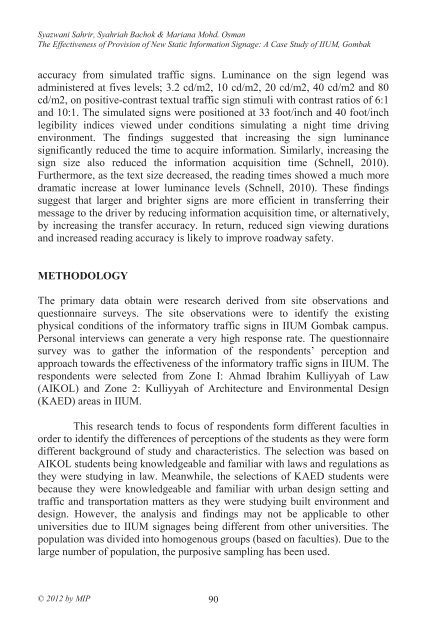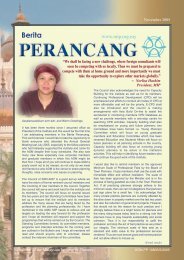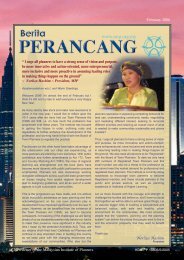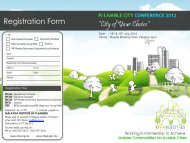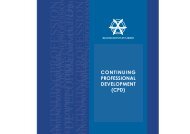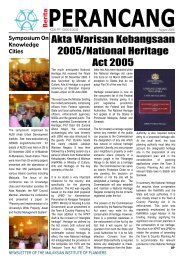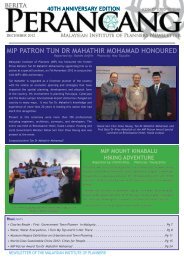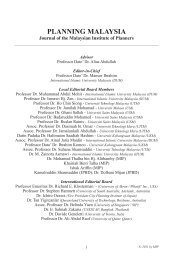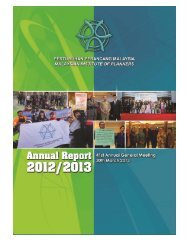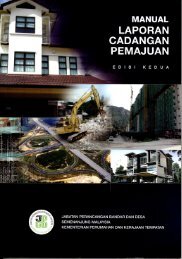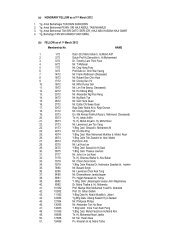Untitled - Malaysian Institute of Planners
Untitled - Malaysian Institute of Planners
Untitled - Malaysian Institute of Planners
Create successful ePaper yourself
Turn your PDF publications into a flip-book with our unique Google optimized e-Paper software.
Syazwani Sahrir, Syahriah Bachok & Mariana Mohd. OsmanThe Effectiveness <strong>of</strong> Provision <strong>of</strong> New Static Information Signage: A Case Study <strong>of</strong> IIUM, Gombakaccuracy from simulated traffic signs. Luminance on the sign legend wasadministered at fives levels; 3.2 cd/m2, 10 cd/m2, 20 cd/m2, 40 cd/m2 and 80cd/m2, on positive-contrast textual traffic sign stimuli with contrast ratios <strong>of</strong> 6:1and 10:1. The simulated signs were positioned at 33 foot/inch and 40 foot/inchlegibility indices viewed under conditions simulating a night time drivingenvironment. The findings suggested that increasing the sign luminancesignificantly reduced the time to acquire information. Similarly, increasing thesign size also reduced the information acquisition time (Schnell, 2010).Furthermore, as the text size decreased, the reading times showed a much moredramatic increase at lower luminance levels (Schnell, 2010). These findingssuggest that larger and brighter signs are more efficient in transferring theirmessage to the driver by reducing information acquisition time, or alternatively,by increasing the transfer accuracy. In return, reduced sign viewing durationsand increased reading accuracy is likely to improve roadway safety.METHODOLOGYThe primary data obtain were research derived from site observations andquestionnaire surveys. The site observations were to identify the existingphysical conditions <strong>of</strong> the informatory traffic signs in IIUM Gombak campus.Personal interviews can generate a very high response rate. The questionnairesurvey was to gather the information <strong>of</strong> the respondents’ perception andapproach towards the effectiveness <strong>of</strong> the informatory traffic signs in IIUM. Therespondents were selected from Zone I: Ahmad Ibrahim Kulliyyah <strong>of</strong> Law(AIKOL) and Zone 2: Kulliyyah <strong>of</strong> Architecture and Environmental Design(KAED) areas in IIUM.This research tends to focus <strong>of</strong> respondents form different faculties inorder to identify the differences <strong>of</strong> perceptions <strong>of</strong> the students as they were formdifferent background <strong>of</strong> study and characteristics. The selection was based onAIKOL students being knowledgeable and familiar with laws and regulations asthey were studying in law. Meanwhile, the selections <strong>of</strong> KAED students werebecause they were knowledgeable and familiar with urban design setting andtraffic and transportation matters as they were studying built environment anddesign. However, the analysis and findings may not be applicable to otheruniversities due to IIUM signages being different from other universities. Thepopulation was divided into homogenous groups (based on faculties). Due to thelarge number <strong>of</strong> population, the purposive sampling has been used.© 2012 by MIP 90


